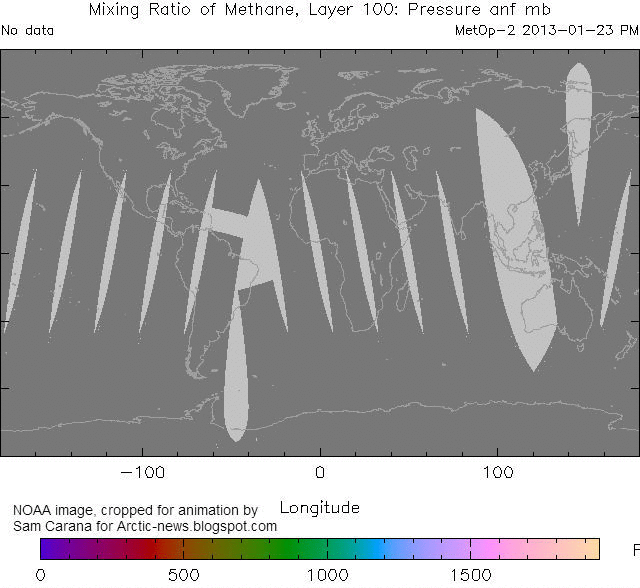The 16-strong team is using state-of-the-art 3D and 2D seismic and echosounder technology to map both forms of methane within the ocean and beneath the seafloor.
The area off the North Island’s east coast is known to have very large active landslides, up to 15km long and 100m thick, and the team set out to discover what is causing them to move.
What they discovered was direct evidence of widespread gas in the sediment and ocean, and indications of large areas of methane hydrate, ice-like frozen methane, below the seafloor. The team has identified 99 gas flares in a 50 km² area, venting from the seabed in columns up to 250 m high. This is believed to be the densest concentration of seafloor gas vents known in New Zealand. 3D seismic data show that landslides and faults allow the gas built up in the sediment to be released into the ocean.
 |
| A 3D image of one section of New Zealand's East Coast seafloor mapped in 3D, complete with methane deposits and flares. [NIWA] |
“Previously all gas venting sites have been in deeper water and associated with large earthquake faults”, says NIWA marine geologist and voyage leader Dr Joshu Mountjoy.
“What we have found is high density methane flares in very shallow water, as well as gas building up beneath a large landslide and being released along the landslide margins”.
In a recently submitted scientific paper the team proposed that these landslides might be the seafloor equivalent of glaciers, but with frozen methane instead of water ice, or alternatively that pressurized gas is causing them to progressively move downslope. The results from this expedition indicate that both of these are possibilities and provide data to carefully test these hypotheses.
The expedition took the opportunity to deploy the German research institute GEOMAR’s high resolution 3D seismic equipment known as the P-Cable from NIWA’s research vessel Tangaroa
“This equipment is the best available for imaging fluid systems within the seafloor,” says co-leader Professor Sebastian Krastel of the University of Kiel. “The sediment, rocks and fluids we have mapped here are perfectly suited to this equipment, and the area mapped is one of the biggest ever mapped with the P-Cable seismic system.”
The work forms part of a larger project focused on understanding the dynamic interaction of gas hydrates and slow moving active landslides. Dubbed SCHLIP (Submarine Clathrate Hydrate Landslide Imaging Project), ongoing investigations in the project over the next decade will including drilling into the landslides themselves in 2016. This first part of the project, SCHLIP-3D, is a collaboration between NIWA, GNS Science and the University of Auckland from New Zealand, GEOMAR and the University of Kiel from Germany, Oregon State University from the USA, and the University of Malta.
“The initial findings are very important”, says Dr Mountjoy. “Methane is a very effective greenhouse gas and seabed methane release has the potential to dramatically alter the earth’s climate. As ocean temperatures change the methane hydrate system has the potential to become unstable.”
“In terms of natural hazards, the occurrence of very large slow landslides, rather than catastrophic ones, has major implications for the tsunami generating potential of landslides globally as slow landslides are unlikely to cause tsunami”.
“This type of slow moving submarine landslide is essentially unknown around the world, but it is very likely that they do occur widely and are an important process shaping continental margins”.
The team set off from Wellington on 14 April and finish the voyage there on 8 May. The work is funded from New Zealand by MBIE and Germany by DFG.
Source
News Release, May 12, 2014, NIWA (National Institute of Water and Atmospheric Research), New Zealand
Related
Sea of Okhotsk














































